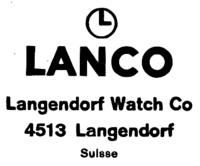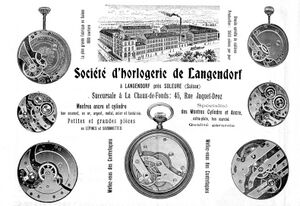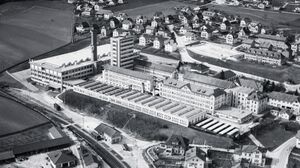Lanco: Difference between revisions
| Line 30: | Line 30: | ||
Rudolf Kottmann died on August 9, [[1952]]. | Rudolf Kottmann died on August 9, [[1952]]. | ||
==Hans Kottmann== | ==Hans and Guido Kottmann== | ||
[[File:1958 ETH-BIB-Langendorf-LBS H1-020958 crop.jpg|right|thumb|300px|The expanded Lanco factory in 1958, including the new 10 story tower]] | [[File:1958 ETH-BIB-Langendorf-LBS H1-020958 crop.jpg|right|thumb|300px|The expanded Lanco factory in 1958, including the new 10 story tower]] | ||
The company claimed to be the largest watch factory in Switzerland in [[1959]], building a new facility in Langendorf to employ 1500 employees and produce a wide variety of models. Lanco moved eagerly into the world of electric clocks, using a LIP movement. | The company claimed to be the largest watch factory in Switzerland in [[1959]], building a new facility in Langendorf to employ 1500 employees and produce a wide variety of models. Lanco moved eagerly into the world of electric clocks, using a LIP movement. | ||
Revision as of 12:39, 28 May 2024

Lanco was the common brand of the Langendorf Watch Company.
Johann Kottmann
Uhrenfabrik Längendorf (the Langendorf Watch Company) was officially founded in 1877 but dates to somewhat earlier. It was established by Johann Viktor Kottmann (1822-1881) and Mr. Meyer. Kottmann's father founded a tobacco workshop in Langendorf in 1844, and Johann took over management of that company after his military service.
In 1873, Johann Kottmann switched the focus of his business to watchmaking. The firm took advantage of the rising demand for ebauches and availability of industrial machinery to produce ebauches for the many firms emerging in German-speaking Switzerland between Bienne and Grenchen. in 1881, Johann Kottmann died of a stroke while on assignment for the military in Lucerne.
Charles Kottmann
Following the death of the founder Langendorf Watch Company was managed by Johann's nephew Charles or Karl Kottmann (1844-1890). One of his first acts was to reorganize the company as a stock corporation, which took effect on August 28, 1882. He became director of the firm (listed as Charles Kottmann), with the board of directors composed of Major Zepfel (president), Leo Niggli (vice-president), J. Roth-Bloch, and Joseph Adler, cantonal councilor.
The Langendorf factory quickly grew to be the largest watch movement factory in Switzerland, ahead of Omega in Bienne and Longines in Saint-Imier. It employed over 800 workers. The company soon began producing finished watches as well In 1895 the firm registered the SHL brand, with the Lanco brand soon following.
Lucien Tièche

Charles Kottmann died suddenly on January 16, 1900. The board of directors promoted technical director Lucien Tièche to manage the business, and he continued to mechanize production to increase productivity. Watch movements were produced on a moving assembly line, and an in-house dial and case making capability was soon added.
Rudolf Kottmann

In 1901 Rudolf Kottmann (1878-1952) joined the firm. He rose to become chairman and managed it for decades along with his brother Ernst (1875?-1944).
The company soon filed its first patents and registered additional brands. Seeking new markets, Langendorf was partner in the American Swiss Watch organization, which failed and was bankrupt in 1915. But the Langendorf factory continued to expand, employing 1500 workers and producing 3,000 watches daily at this point. After World War I production hit 750,000 watches per year.
Another joint venture in America, with Ptetzfelfder & Mills of New York, was more successful, even opening a branch in La Chaux-de-Fonds in 1925. And the firm began using the Lonville brand in the United States at this time, producing high-quality watches. By 1928 the company was also using the Lanco, Vera, Trovato, Langendorf, and other brand names.
In 1940 Langendorf appeared at the New York World's Fair, boasting the large factory and international success. The Lanco-Fon, an alarm model, was presented at the Basel Fair in 1949 and this became a well-known product, competing with the legendary Vulcain Cricket.
Rudolf Kottmann died on August 9, 1952.
Hans and Guido Kottmann

The company claimed to be the largest watch factory in Switzerland in 1959, building a new facility in Langendorf to employ 1500 employees and produce a wide variety of models. Lanco moved eagerly into the world of electric clocks, using a LIP movement.
By 1962 the company was run by Hans Kottmann (1910-1964), with Paul Jenny serving as managing director. The factory measured 40,000 square meters, with a 10 story tower looming above Langendorf. The factory was entirely vertically integrated, producing ebauches, dials, cases, assortments, spares, and more, and produced over 4,000 watches daily. Lanco created a line of uniform movements in the 1960s, including 5.5, 6.75, and 5.25 ligne movements for women and an 11.5 ligne movement with optional calendar for men.
The company's longstanding mechanized production line lead the firm to produce such machines for sale in the 1960s. The "Lanco Economic" production system distributed parts on the assembly line and would become the primary focus for the company.
SSIH
Hans and Guido Kottmann (1913-1965) were approached by both SSIH and ETA in 1964 about an acquisition, with both groups seeking to increase production. When both men died the following year, Lanco's board decided to take the SSIH offer. It became the mass-market leader below Tissot and Omega. This was part of an effort by SSIH to conquer the mid-range and low-end watch markets, and to increase production over 1 million watches annually. This was successful thanks to Lanco, which brought the group to 1.7 million watches by 1970.
But the crisis of the 1970s proved a serious challenge to this goal. SSIH acquired Economic Swiss Time Holding in 1971, and a rationalization of production was urgently needed. Omega and Tissot prevailed, thanks to their privileged position in the holding company, and Lanco was forced to stop producing watch movements. 25% of the workforce was dismissed in 1972 as the firm focused on watch assembly, manufacture of dials, and production of the Lanco Economic assembly system.
In the 1970s, Lanco used Tissot movements, including the Astrolon, a watch that used plastic wheels. And Lanco's brand was used on mass produced quartz and digital LED watches. Eventually the large factory in Langendorf was superfluous. Management of the Lanco Economic division purchased it in 1981 to form a separate company. Following the merger of SSIH and ASUAG in 1983 the Lanco brand was discontinued.
The main Lanco factory, with the 10-story tower, is now a large Migros supermarket, while the rest of the factory was demolished.
Timeline
- 1877 - Uhrenfabrik Längendorf is established by Kottmann & Meyer
- 1882, August 28 - At an official meeting the Uhrenfabrik Längendorf becomes a public limited company; share capital is 200,000 francs, with a further 100,000 francs envisaged; director of the company is C. Kottmann; members of the board of directors are Major Zepfel as president, Leo Niggli as vice-president, J. Roth-Bloch, and Joseph Adler; business premises is building no. 49 and 49 B in Langendorf
- 1888, March 8 - Share capital is 300,000 francs; 200 new shares of 1000 francs are authorized; the Board of Directors authorizes the issuance of bonds to raise capital
- 1890, January 20 - Following the death of director Carl Kottmann, Lucien Tièche is given authority
- 1890, February 14 - Lucien Tièche is officially made director
- 1891, November 26 - Albert Frölicher, Hermann Strausak, and Arnold Sauser are given power of attorney
- 1894, February 31 - Arnold Sauser has resigned; Albert Fröhlicher and Hermann Strausak remain in charge
- 1896, March 17 - The company is officially renamed Uhrenfabrik Langendorf (rather than Längendorf)
- 1897, November 4 - The collective power of Hermann Strausak and Albert Froelicher is replaced by individual authority for Hermann Strausak; Albert Froelicher's power is collective with Chairman of the Board of Directors, Dr. A. Kottmann